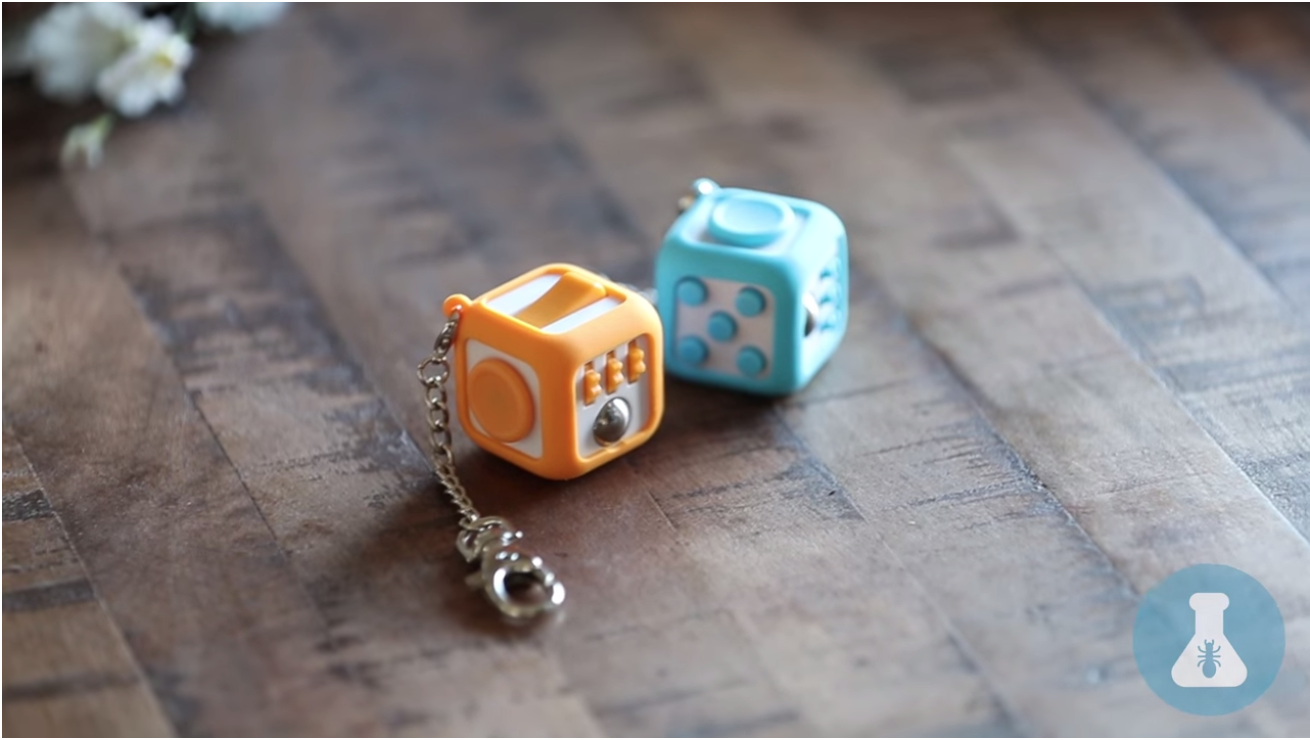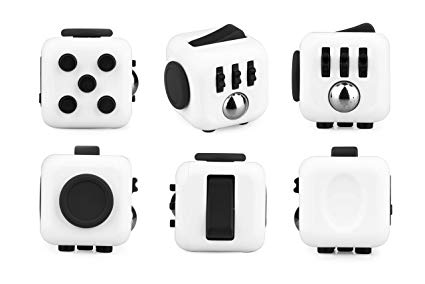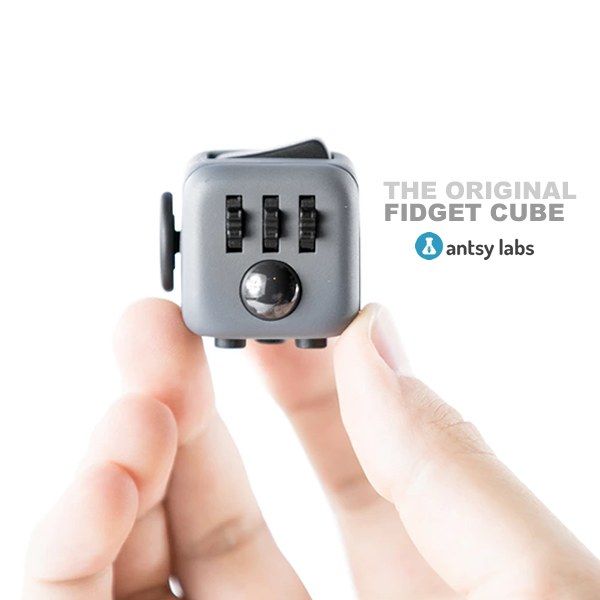The Fidget Cube is a six-sided hand-held toy designed to encourage focus by enabling fidgeting behavior. Each side of the Fidget Cube presents a different form of tactile engagement: a switch, a wheel, a joystick, a series of lock gears, five buttons of varying resistance, and an oval impression based on a worry stone.
The Fidget Cube is sold as a “high-quality desk toy” that will let users turn fidgeting into focusing, “in style” [1]. It is made out of hard plastic and has curved, rounded edges to soften the shape and help it sit more comfortably in a person’s hand. Though it is compact, it is a little too large to easily fit in a pocket. The plastic buttons, switches, and toggles are typically a different color from the body so that they stand out; the body and button colors can be selected from a menu of options on the product page, but are not fully customizable. The overall appearance is sleek, neither childish nor medical. The base price on Antsy Labs’ website is an affordable $12.99. Users who want to further customize their Fidget Cube – and perhaps improve portability – may also purchase the “Prism” keychain attachment ($4.99), which is a soft silicone sheath that wraps around the edges of the cube and attaches to a metal keychain.

Fidget Cubes and Prism keychains, Antsy Labs.
Fidgeting, defined as the act of moving or behaving restlessly, can be caused by feelings of agitation, nervousness, or boredom, and often occur without the fidgeter being aware of it [2]. While anyone can find themselves fidgeting, the need to move or fidget in response to cognitive state takes on particular importance for people with attention deficit hyperactivity disorder (ADHD), autism, anxiety, and similar conditions. Antsy Labs does not make a reference to neurodivergence on the product page for the Fidget Cube, but rather promotes their product as a general focusing aid that can increase anyone’s concentration and efficiency by meeting the need to fidget.
How can a toy designed explicitly for fussing with improve one’s focus? Traditionally, fidgeting is seen as an expression of disinterest, especially in academic or professional settings. Research into attention and restlessness, however, has indicated that fidgeting actually improves information retention and cognitive engagement, suggesting that fidgeting may actually be a subconscious expression of the brain’s attempts to stay on task and provide stimulation in order to increase focus [3]. In a manner of speaking, fidgeting distracts the mind from its own distractibility. This perspective aligns with the social model of disability: because some individuals, such as many people with ADHD, are able to focus more easily when fidgeting, they should be able to modify their environment with tools that are satisfying to fidget with, and should be allowed to use those tools as needed [4].
With a different interactive surface on every side, the Fidget Cube has numerous points of tactile stimulation that help to occupy fidgeting impulses. Users can press a variety of buttons and switches, swivel a joystick, rotate balls and wheels, and roll the entire cube around in their hand, switching between sides if one action loses appeal. Most of these interactive components also have an element of texture – differing levels of resistance, or teeth that click along an internal gear.

This versatility makes the Fidget Cube very engaging – in fact, perhaps too engaging. Parents of children who benefit from fidgeting in the classroom have expressed concern that the Fidget Cube is too toy-like to actually help their children stay focused, and many educators have banned the use of Fidget Cubes in their classrooms, instead favoring simpler fidgets such as putty, stress balls, or seats that are designed to swivel [5]. But there is a more glaring flaw in the Fidget Cube that makes it incompatible with many attention-demanding settings: half of its movable parts produce noise. What I referred to as a textural quality above means that several components (the gears, the switch, the high-resistance buttons) create audible clicks when used [6]. This physical and auditory feedback might be very satisfying to the user, but it is disruptive to everyone around them. The worst offender is the gliding click switch, which I have to cover with masking tape if I want to avoid accidentally making loud clicking noises when I use my own Fidget Cube in class or at work. Unfortunately, while the cube’s appearance and marketing normalizes fidgeting as something trendy and sophisticated, the noise issue means that the Fidget Cube is best used in isolation. The cube would have to be made silent in order to more seamlessly integrate into many fidgeters’ daily lives.
Bibliography
[1] “Fidget Cube.” Antsy Labs. https://www.antsylabs.com/collections/shop/products/fidget-cube
[2] Weiss, Thomas C. “Fidgeting and ADHD.” Disabled World, July 28, 2015; revised October 20, 2017. https://www.disabled-world.com/health/neurology/adhd-autism/fidgeting.php
[3] Farley, James, Evan F. Risko, and Alan Kingstone. “Everyday attention and lecture retention: The effects of time, fidgeting, and mind wandering.” Frontiers in Psychology 4: 619, September 18, 2013. https://www.ncbi.nlm.nih.gov/pmc/articles/PMC3776418/
[4] “How can fidget spinners and cubes actually help with anxiety and ADHD?” Time Psychology. https://timepsychology.com/journalists/can-fidget-spinners-cubes-actually-help-anxiety-adhd-read-httpmetro-co-uk20170427how-can-fidget-spinners-cubes-actually-help-anxiety-adhd/
[5] “Fidget Toys and ADHD: Still Paying Attention?” ADHD Weekly, Children and Adults with Attention Deficit/Hyperactivity Disorder (CHADD), January 31, 2019. https://chadd.org/adhd-weekly/fidget-toys-and-adhd-still-paying-attention/
[6] Bohn, Deiter. “The Fidget Cube is basically a baby toy for adults and I love it.” The Verge, February 7, 2017. https://www.theverge.com/circuitbreaker/2017/2/7/14541632/fidget-cube-review-desk-toy-kickstarter
